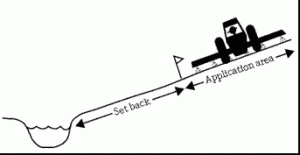This section describes buffers used to reduce runoff and water erosion potential.
Water buffers within fields
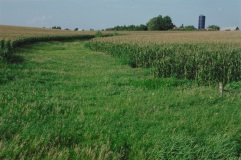 Grassed waterway— a natural or constructed vegetated channel that is shaped and graded to carry surface water at a non-erosive velocity to a stable outlet. Because of the concentrated flow that usually occurs in waterways, sediment trapping and water infiltration can be minimal with large runoff events, but substantial with smaller events. Waterways are most effective in trapping sediment and dissolved chemicals when designed to spread concentrated water flow over a vegetated filter adjacent to streams.
Grassed waterway— a natural or constructed vegetated channel that is shaped and graded to carry surface water at a non-erosive velocity to a stable outlet. Because of the concentrated flow that usually occurs in waterways, sediment trapping and water infiltration can be minimal with large runoff events, but substantial with smaller events. Waterways are most effective in trapping sediment and dissolved chemicals when designed to spread concentrated water flow over a vegetated filter adjacent to streams.
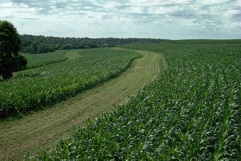 Contour buffer strips— strips of perennial vegetation alternated with wider cultivated strips that are farmed on the contour. Buffers are most effective in trapping pesticides when runoff enters uniformly as sheet flow. Contour buffer strips are one of the most effective buffers to trap pesticides. There is less chance for concentrated flow, and smaller areas of cultivated field deliver runoff directly to each strip within a relatively short distance compared to some edge-of-field buffers.
Contour buffer strips— strips of perennial vegetation alternated with wider cultivated strips that are farmed on the contour. Buffers are most effective in trapping pesticides when runoff enters uniformly as sheet flow. Contour buffer strips are one of the most effective buffers to trap pesticides. There is less chance for concentrated flow, and smaller areas of cultivated field deliver runoff directly to each strip within a relatively short distance compared to some edge-of-field buffers.
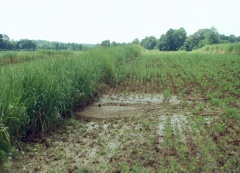 Vegetative barriers— narrow, permanent strips of stiff-stemmed, erect, tall, dense, perennial vegetation established in parallel rows and perpendicular to the dominant slope of the field. These barriers function similarly to contour buffer strips and may be especially effective in dispersing concentrated flow, thus increasing sediment trapping and water infiltration.
Vegetative barriers— narrow, permanent strips of stiff-stemmed, erect, tall, dense, perennial vegetation established in parallel rows and perpendicular to the dominant slope of the field. These barriers function similarly to contour buffer strips and may be especially effective in dispersing concentrated flow, thus increasing sediment trapping and water infiltration.
Edge-of-field Water Buffers
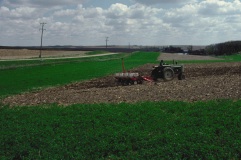 Field borders— a band or strip of perennial vegetation established on the edge of a cropland field. This buffer reduces pesticide runoff only when runoff flows over the strip. Even when no water flows over the strip, some water quality benefit may be gained because spraying operations are physically separated from adjacent areas, reducing drift and direct application to riparian areas.
Field borders— a band or strip of perennial vegetation established on the edge of a cropland field. This buffer reduces pesticide runoff only when runoff flows over the strip. Even when no water flows over the strip, some water quality benefit may be gained because spraying operations are physically separated from adjacent areas, reducing drift and direct application to riparian areas.
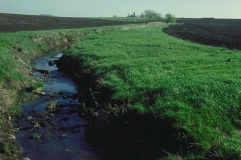 Filter strips— areas of grass or other permanent vegetation used to reduce sediment, organics, nutrients, pesticides, and other contaminants in runoff and to maintain or improve water quality. Filter strips are located between crop fields and water bodies. More pesticides can be removed by encouraging as much sheet-flow as possible across the strip and minimizing concentrated flow. This may be accomplished by combining filter strips with other conservation practices that control concentrated flow, such as vegetative barriers, level spreaders, or water bars.
Filter strips— areas of grass or other permanent vegetation used to reduce sediment, organics, nutrients, pesticides, and other contaminants in runoff and to maintain or improve water quality. Filter strips are located between crop fields and water bodies. More pesticides can be removed by encouraging as much sheet-flow as possible across the strip and minimizing concentrated flow. This may be accomplished by combining filter strips with other conservation practices that control concentrated flow, such as vegetative barriers, level spreaders, or water bars.
Setbacks— untreated areas where surface runoff enters streams. Some herbicide labels describe leaving these areas untreated. Seeding these areas with perennial grass improves herbicide trapping compared to trapping with an untreated row crop.
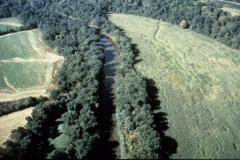
Riparian forest buffer— an area of trees and shrubs located adjacent to streams, lakes, ponds, and wetlands. Forest buffers are often combined with perennial grass buffers. Woody vegetation provides food, and cover for wildlife helps lower water temperatures by shading the water body, contributes energy sources to aquatic communities, protects stream banks, and slows out-of-bank flood flows. Deep tree roots may intercept nitrate entering streams through shallow subsurface flow and provide soil carbon for microbial energy. Microbes can degrade pesticides and denitrify nitrate.
Constructed wetlands
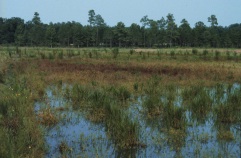 While pesticides are usually carried to streams in surface runoff, most nitrate is carried to streams in subsurface flow. Subsurface flow may also have low concentrations of pesticides. Riparian buffers can intercept shallow subsurface flow and cause either uptake of nitrate and utilization by plants or encourage denitrification. Drainage tiles bypass buffers and deliver subsurface drainage directly to streams. Wetlands constructed at tile outlets or as part of a riparian buffer system can effectively degrade pesticides and denitrify nitrate.
While pesticides are usually carried to streams in surface runoff, most nitrate is carried to streams in subsurface flow. Subsurface flow may also have low concentrations of pesticides. Riparian buffers can intercept shallow subsurface flow and cause either uptake of nitrate and utilization by plants or encourage denitrification. Drainage tiles bypass buffers and deliver subsurface drainage directly to streams. Wetlands constructed at tile outlets or as part of a riparian buffer system can effectively degrade pesticides and denitrify nitrate.
Source – Conservation Buffers to Reduce Pesticide Losses
Original content compiled by:
